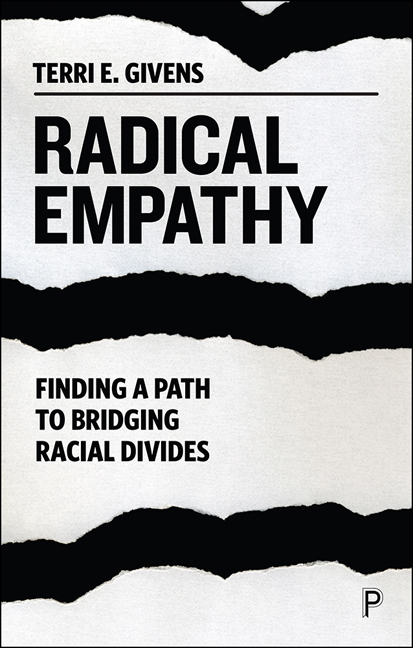Book contents
- Frontmatter
- Dedication
- Contents
- Note on the author
- Prologue:Writing in a time of crisis
- 1 Bridging divides: From racism to empathy in the 21st century
- 2 Getting to radical empathy
- 3 My family’s story: The isolation of internalized oppression
- 4 Racism and health disparities
- 5 Finding empathy in the academy
- 6 Love and marriage
- 7 Radical empathy in leadership: Creating change
- 8 Creating change at the national level: Restorative justice and working off the past
- 9 Revisiting the path to radical empathy
- Epilogue: The long road ahead
- Notes
- Suggested reading
- Index
8 - Creating change at the national level: Restorative justice and working off the past
Published online by Cambridge University Press: 05 January 2022
- Frontmatter
- Dedication
- Contents
- Note on the author
- Prologue:Writing in a time of crisis
- 1 Bridging divides: From racism to empathy in the 21st century
- 2 Getting to radical empathy
- 3 My family’s story: The isolation of internalized oppression
- 4 Racism and health disparities
- 5 Finding empathy in the academy
- 6 Love and marriage
- 7 Radical empathy in leadership: Creating change
- 8 Creating change at the national level: Restorative justice and working off the past
- 9 Revisiting the path to radical empathy
- Epilogue: The long road ahead
- Notes
- Suggested reading
- Index
Summary
The last and most important step on the path of radical empathy is creating change and building trust. What does change look like? It isn't necessarily something that happens immediately—it can take many years to see the results of efforts to bridge longstanding divides. One of the most powerful reasons for practicing radical empathy is conflict resolution. In this chapter I explore ways to find a positive path forward in a country where people can live and work together while acknowledging the impact of the past. In the two cases I discuss in this chapter, in Germany and South Africa, change didn't happen quickly. It took time to move past the pain and damage done during times of oppression and violence in these countries. Those processes continue as new ways are explored to heal and support those who were deeply impacted.
I have been privileged to travel the world in my time as a political scientist, including places where racial oppression and conflict were part of the political landscape. I have met politicians and leaders from a variety of countries, but the places that had the most impact on me in terms of their approach to dealing with the past were Germany and South Africa.
The advice to learn German in graduate school was very useful—most of the funding I received for my research over the years came from German sources. However, I also developed a connection with people in Germany who gave me a better understanding of the complexities they faced with having a German identity that was tied to a horrific time of genocide.
We didn't learn much about the Holocaust when I was in school, and my main source of information before I went to college was movies. I don't think I would have enjoyed the television sitcom “Hogan's Heroes” as much if I had known more about the atrocities that were happening during that time in history. The bumbling Germans in the show bear no resemblance to the efficient murderers I learned about in my college history courses.
I developed an interest in South Africa when I was in elementary school.
Information
- Type
- Chapter
- Information
- Radical EmpathyFinding a Path to Bridging Racial Divides, pp. 133 - 150Publisher: Bristol University PressPrint publication year: 2021
